List of universal first aid kits. Price, composition and shelf life of a new car first aid kit
A car often takes us to places far from civilization. If health problems arise on the road or in the wilderness, then the driver, willy-nilly, becomes “his own doctor,” trying to find a first-aid kit in the trunk, which he often... never looked into! How to make it so that Hard time Did the first aid kit help out, but not turn out to be useless?
First aid kit from the store - what's in it?
The current requirements for car first-aid kits, which exclude medications from them and leave only dressings, have been in effect since July 1, 2010. After their introduction, there was a lot of noise about how the previously useless first aid kit had become even more useless, but, unfortunately, these conversations have long died down. And many of the neophyte drivers who increase the number of drivers every year simply do not think about the fact that a ready-made first aid kit bought automatically on the principle of “you have to, then you have to...” is only a “disclaimer” for a technical inspection. An excuse, that is. There is a first aid kit, there is a certificate - that means order. However, the actual contents of the medical boxes can only cause nervous laughter among those who understand... Let's see what the contents of three different first aid kits look like, which we bought for 100, 200 and 250 rubles.
The hundred-ruble first aid kit, the size of one and a half fists, is attractive due to its compactness - it can be conveniently placed in the glove compartment or door pocket. But filling it is a complete failure... Obviously, the main element of the content is a certificate of conformity valid until November 2017. It is, of course, necessary during a technical inspection - but it will only help with it: in case of real injuries, the first aid kit does not even need to be opened...
- Non-sterile gauze bandage 5 m x 7 cm – 2 pcs.
- Adhesive plaster sticker – 1 pc.
- The “hemostatic tourniquet” is a natural piece of elastic from panties, there are simply no sterile bandages, and the adhesive plaster is represented by one measly piece of paper!
Such a set should be given to a child immediately after the technical inspection to play doctor - it is good for nothing else.
We take on a set that is twice as expensive – for 200 rubles. But is it twice as good?
- Hemostatic tourniquet – 1 pc.
- Adhesive plaster sticker – 2 pcs.
- Mouth-to-mouth artificial respiration device – 1 pc.
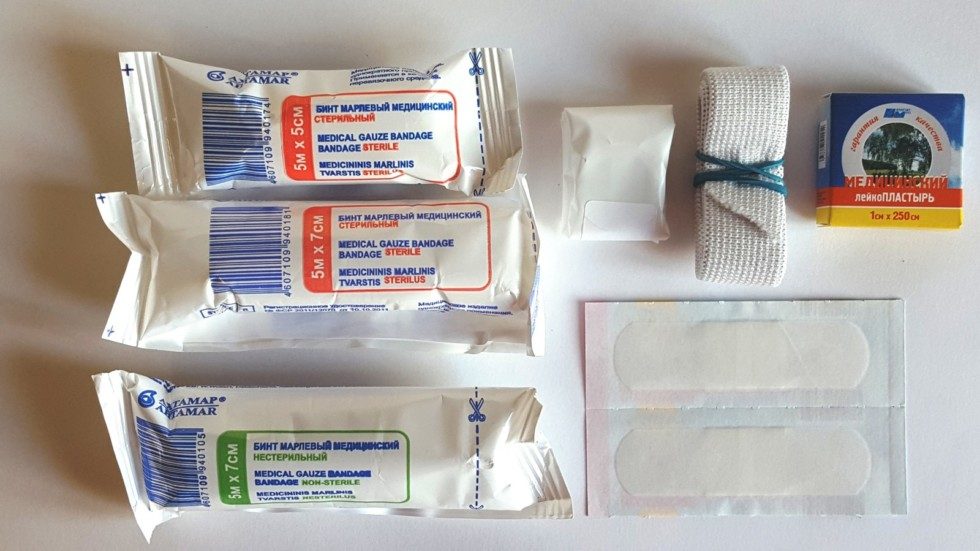 This set-up at least already has a sterile bandage, not one, but two “slap” patches, and a thin roll of tape has also been added. But, to be honest, it’s practically the same thing... And the verdict is the same - a child’s toys!
This set-up at least already has a sterile bandage, not one, but two “slap” patches, and a thin roll of tape has also been added. But, to be honest, it’s practically the same thing... And the verdict is the same - a child’s toys!
And the last set - for 250 rubles. A large suitcase with a handle, giving hope for more or less decent contents. What's in it?
- Hemostatic tourniquet – 1 pc.
- Non-sterile gauze bandage 5 m x 7 cm – 1 pc.
- Non-sterile gauze bandage 5 m x 5 cm – 1 pc.
- Sterile gauze bandage 5 m x 7 cm – 1 pc.
- Sterile gauze bandage 5 m x 5 cm – 1 pc.
- Adhesive plaster sticker – 2 pcs.
- Rolled adhesive plaster – 1 pc.
- Mouth-to-mouth artificial respiration device – 1 pc.
- Scissors – 1 pc.
- Non-sterile gloves – 1 pc.
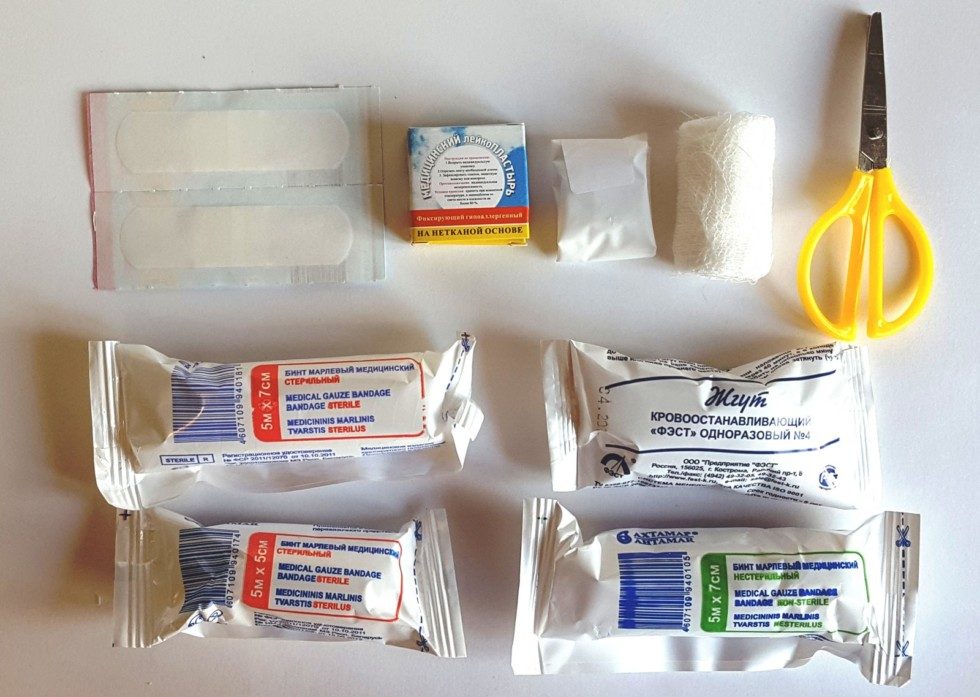 But even here, in reality, the set shows its complete inconsistency: there are still two patches, there are a little more bandages, and the hemostatic tourniquet is a little more serious - nylon tape with Velcro in a vacuum bag. It would be hard to call this set essential. And after you pick up the scissors and gloves, you realize that a first aid kit for 200 rubles is even more honest than the one that costs 250! Scissors are a kind of mockery: crooked and skewed, it is impossible to cut even a slice of cheese with them. The gloves are made of the thinnest polyethylene bags - these are the kind that are available for free at some glamorous gas stations, so as not to get your hands dirty from the gun...
But even here, in reality, the set shows its complete inconsistency: there are still two patches, there are a little more bandages, and the hemostatic tourniquet is a little more serious - nylon tape with Velcro in a vacuum bag. It would be hard to call this set essential. And after you pick up the scissors and gloves, you realize that a first aid kit for 200 rubles is even more honest than the one that costs 250! Scissors are a kind of mockery: crooked and skewed, it is impossible to cut even a slice of cheese with them. The gloves are made of the thinnest polyethylene bags - these are the kind that are available for free at some glamorous gas stations, so as not to get your hands dirty from the gun... 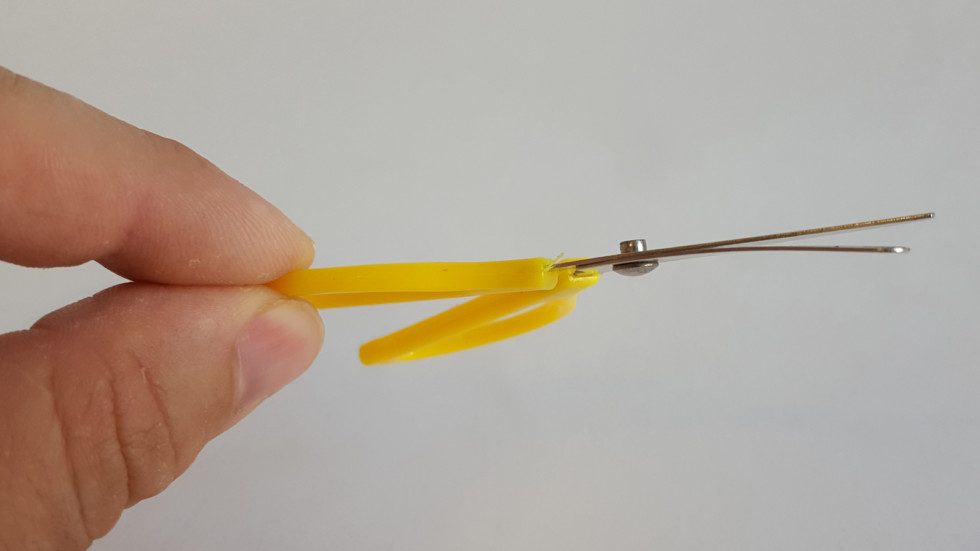
In a word, to pass a technical inspection, a first aid kit for 100 rubles is enough - those that are two to three times more expensive have similar certificates of conformity and are just as useless for their intended use as a hundred-ruble box, so there is not the slightest sense in paying more than a hundred . This means that we will independently assemble a normal first aid kit, which can really help out in case of medical problems along the way.
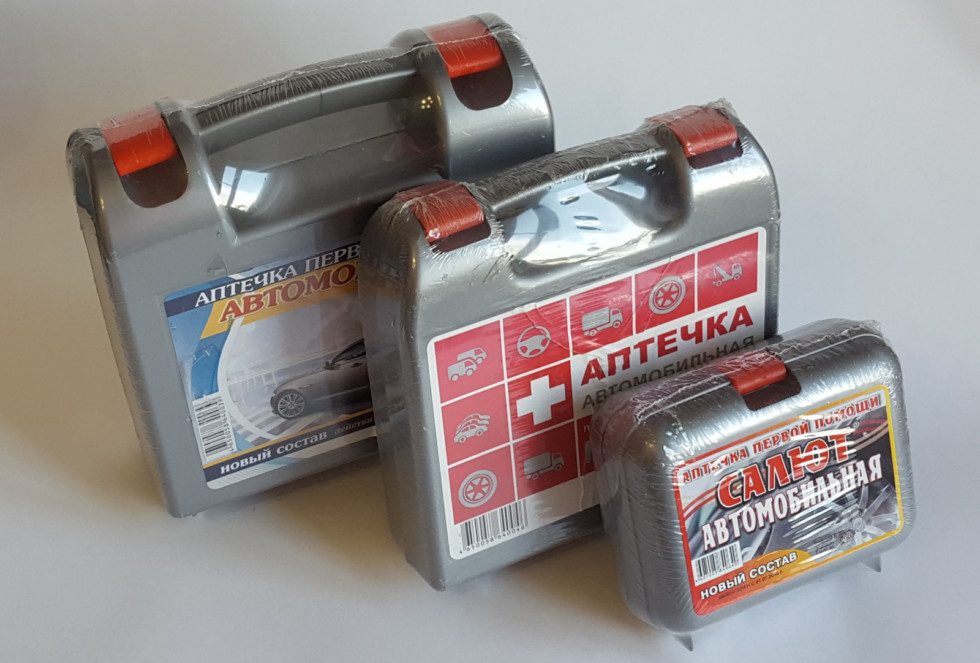 We are collecting a car first aid kit!
We are collecting a car first aid kit!
When collecting the components of the first aid kit, we divide its contents into three groups:
- Dressings
- Disinfectants
- Medications
“In a modern first aid kit, the contents are a very imperfect set of first aid for injuries and various bleeding,” says Nikolai Nikitenko, a rescuer with 20 years of experience, head of the software and information support service for the Tsentrospas detachment.
“The store first aid kit is absolutely missing the so-called individual dressing bags and cooling packs. It is extremely difficult to bandage a wound more serious than a cut with thin gauze strips of bandages - this is what the individual dressing package is designed for. And hypothermic packs will provide cold for bruises, chemical composition which, when mixed by crushing, produces an ice compress.”
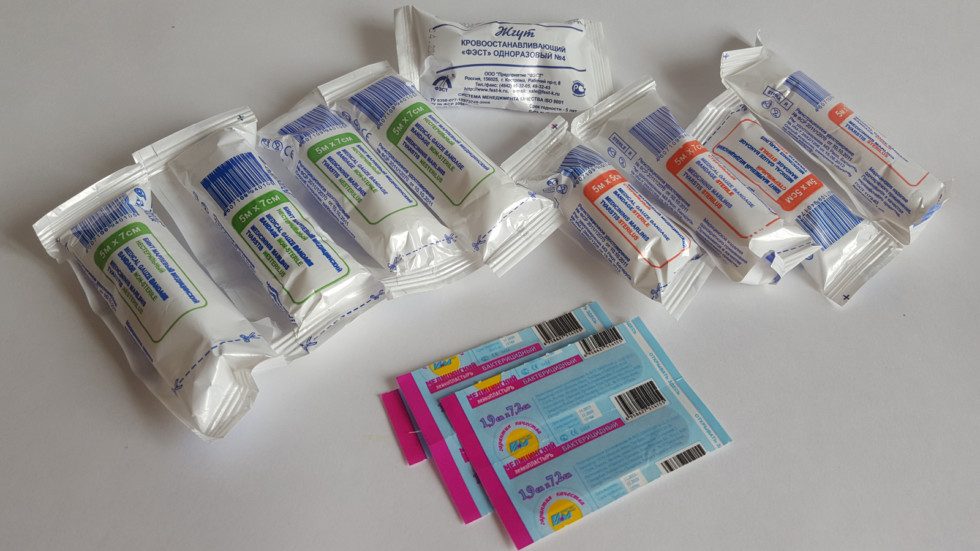 Following the advice of an experienced rescuer, we will add to the symbolic bandages of a first-aid kit several rolls of sterile and non-sterile bandages, a roll of cotton wool, as well as a plate with a dozen sticker patches and a roll of plaster. By the way, if we take all the dressing materials from all three first aid kits that we gutted for research purposes, then at the very least there will be enough bandages for one more or less normal set! Bandages last a long time, so they only need to be renewed as they are used.
Following the advice of an experienced rescuer, we will add to the symbolic bandages of a first-aid kit several rolls of sterile and non-sterile bandages, a roll of cotton wool, as well as a plate with a dozen sticker patches and a roll of plaster. By the way, if we take all the dressing materials from all three first aid kits that we gutted for research purposes, then at the very least there will be enough bandages for one more or less normal set! Bandages last a long time, so they only need to be renewed as they are used.
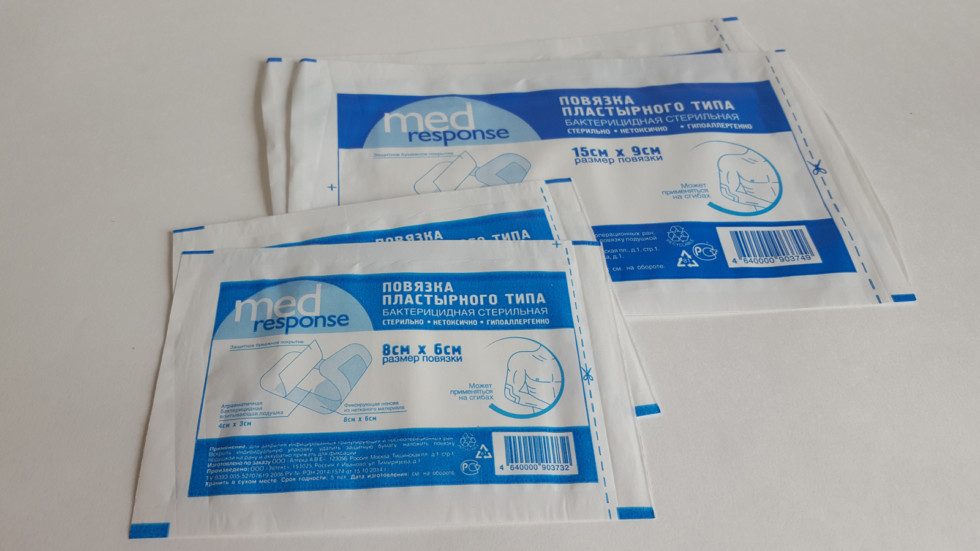 Not in every modern pharmacy you can buy an individual dressing package - the same army one, in a sealed package made of rubberized fabric. This is what car first aid kits used to be equipped with, and they were widely sold. Today, finding this package in a pharmacy is possible, but not easy. Its readily available analogue is bandage patches with dimensions of 15x9 centimeters and 8x6 centimeters. In principle, this is actually the same thing - a bandage is placed on the wound and, to be sure, it is bandaged on top with a non-sterile or sterile bandage. You should have several of these in your car first aid kit, especially since they are cheap and easily stored for several years.
Not in every modern pharmacy you can buy an individual dressing package - the same army one, in a sealed package made of rubberized fabric. This is what car first aid kits used to be equipped with, and they were widely sold. Today, finding this package in a pharmacy is possible, but not easy. Its readily available analogue is bandage patches with dimensions of 15x9 centimeters and 8x6 centimeters. In principle, this is actually the same thing - a bandage is placed on the wound and, to be sure, it is bandaged on top with a non-sterile or sterile bandage. You should have several of these in your car first aid kit, especially since they are cheap and easily stored for several years.
For bruises or fractures, apply cold to the injured area. Chemical cooling packs are used for this purpose. The general package contains banal ammonium nitrate powder and a separate bag of water. The container with water is destroyed by a blow of the palm, after which the water and saltpeter are mixed. During the dissolution reaction, active heat absorption occurs - the bag becomes very cold.
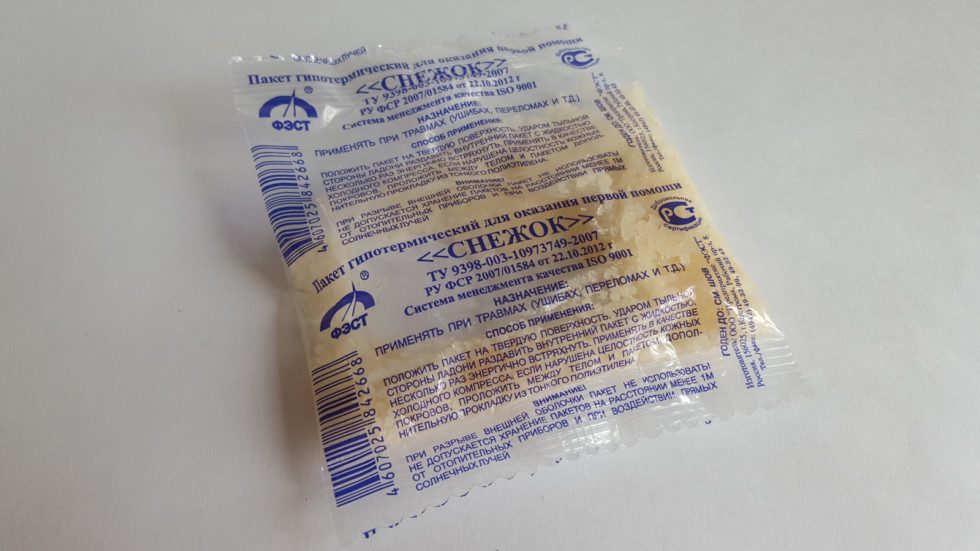 Hypothermic bags are cheap; it is advisable to have 3-4 of them in your first aid kit. They can be stored for a year or two, but are structurally weak: they require a first aid kit in the form of a hard suitcase to protect them from unfortunate proximity to the cargo in the trunk - so that they do not leak.
Hypothermic bags are cheap; it is advisable to have 3-4 of them in your first aid kit. They can be stored for a year or two, but are structurally weak: they require a first aid kit in the form of a hard suitcase to protect them from unfortunate proximity to the cargo in the trunk - so that they do not leak.
Now about disinfectants. As the hero of “High Security Vacation” performed by Bezrukov said, “we choose the classics,” namely, iodine, hydrogen peroxide and alcohol. Oddly enough, the classic packaging in medical bottles with a volume of 40–50 milliliters is most convenient for a car first aid kit, in contrast to expensive “pencils” and the like. Good old bottles are the cheapest, their double stopper (plug + screw cap) is reliable, and the glass walls are thick - the risk of breaking in a car first aid kit is extremely low. Hydrogen peroxide costs less than 10 rubles - so it is advisable to use one bottle as a container for alcohol - just pour out the peroxide, fill the bottle with alcohol and stick on the appropriate label. 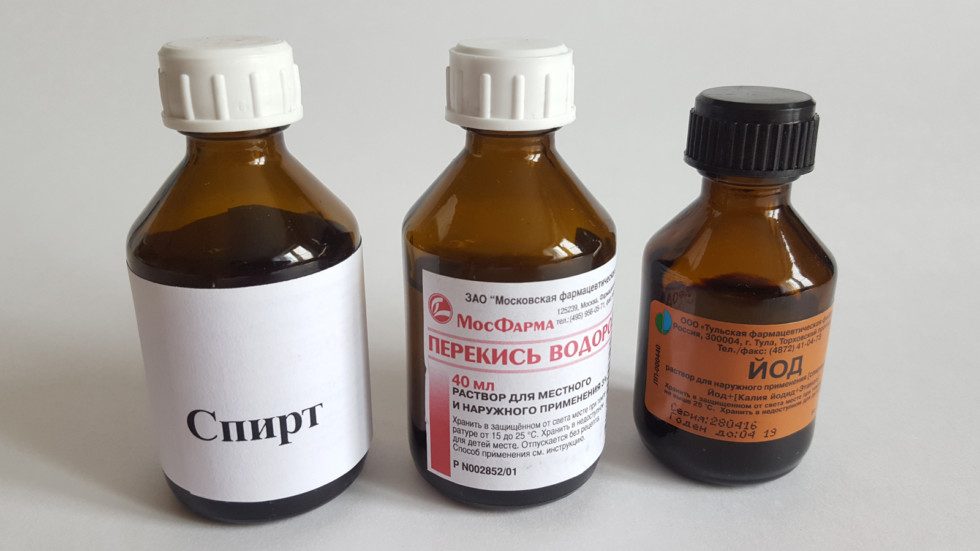
“There is no need to keep heart medications, vascular medications, antiallergic medications and other specialized medications in the car first aid kit “just in case,” says emergency physician Anatoly Belov.
“A single driver who knows his diagnoses should have vital medications in a separate mini travel bag, stored not in the car, but in a purse with documents and keys. The passenger needs to act similarly if he is a stranger to the driver. If you are planning a family trip, then the medications needed for each need to be temporarily added to the first aid kit, and after returning, take away everything unused from there to avoid damage.”
 It is worth keeping a minimum of medications in your car first aid kit at all times for sudden problems that are not related to chronic diseases, inexpensive and that can be replaced at least once a year without much damage due to difficult storage conditions. IN long journey, in the outback, far from populated areas, pharmacies and hospitals, the following most often happens to a driver:
It is worth keeping a minimum of medications in your car first aid kit at all times for sudden problems that are not related to chronic diseases, inexpensive and that can be replaced at least once a year without much damage due to difficult storage conditions. IN long journey, in the outback, far from populated areas, pharmacies and hospitals, the following most often happens to a driver:
- Various types of pain - headaches, muscle pain, etc.
- Stomach problems, diarrhea, poisoning
- Colds, sore throat
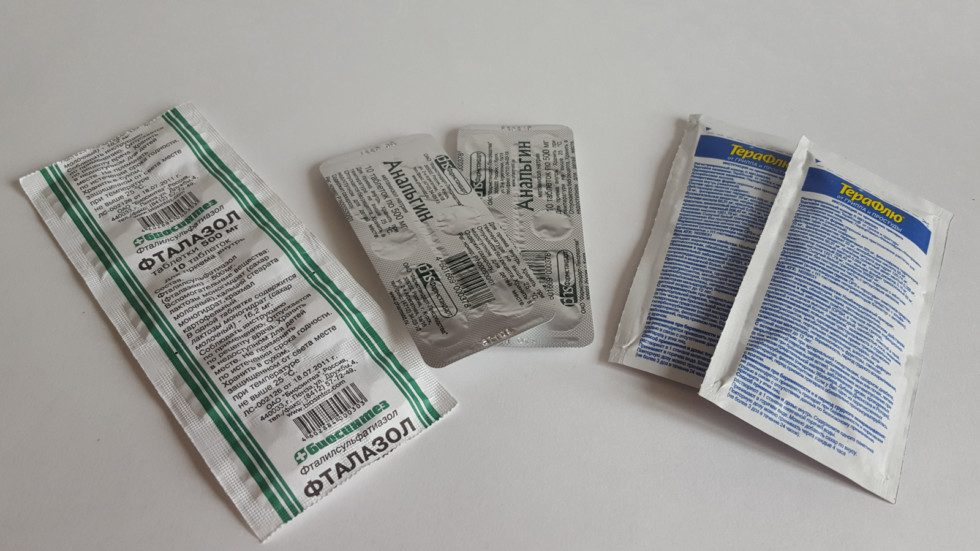 For pain of different nature enough banal analgin, baralgin and No-Shpa, which, even expired, will not turn into poison, although they will reduce effectiveness. Painkillers will allow you to get to your destination safely, thinking about the road, and not about the pain, and then see a doctor. The well-known Phthalazol, Smecta, Mezim, Imodium and the like will help with gastrointestinal problems. In case you get a sore throat, a runny nose, a cough, or even a rise in temperature along the way, again, there is no need to carry all imaginable medications with you. You need to get home without getting into an accident due to weakness and fever, and then begin full treatment there! Therefore, in your car first aid kit for such a case, you should only have a couple of sachets of soluble express powders like Teraflu or analogues. Impact doses of paracetamol and ascorbic acid will not cure, but will relieve symptoms and bring you to your senses. Well, put a blister of plain aspirin too. That, in general, is all you need to know about the basic medicinal part of a first aid kit!
For pain of different nature enough banal analgin, baralgin and No-Shpa, which, even expired, will not turn into poison, although they will reduce effectiveness. Painkillers will allow you to get to your destination safely, thinking about the road, and not about the pain, and then see a doctor. The well-known Phthalazol, Smecta, Mezim, Imodium and the like will help with gastrointestinal problems. In case you get a sore throat, a runny nose, a cough, or even a rise in temperature along the way, again, there is no need to carry all imaginable medications with you. You need to get home without getting into an accident due to weakness and fever, and then begin full treatment there! Therefore, in your car first aid kit for such a case, you should only have a couple of sachets of soluble express powders like Teraflu or analogues. Impact doses of paracetamol and ascorbic acid will not cure, but will relieve symptoms and bring you to your senses. Well, put a blister of plain aspirin too. That, in general, is all you need to know about the basic medicinal part of a first aid kit!
An “anti-splinter” kit in a separate bag is very necessary and useful in a car first aid kit. It should include sewing needle or a pin and nail tweezers. And to disinfect instruments and the “operation” site, that same small bottle of alcohol is used. 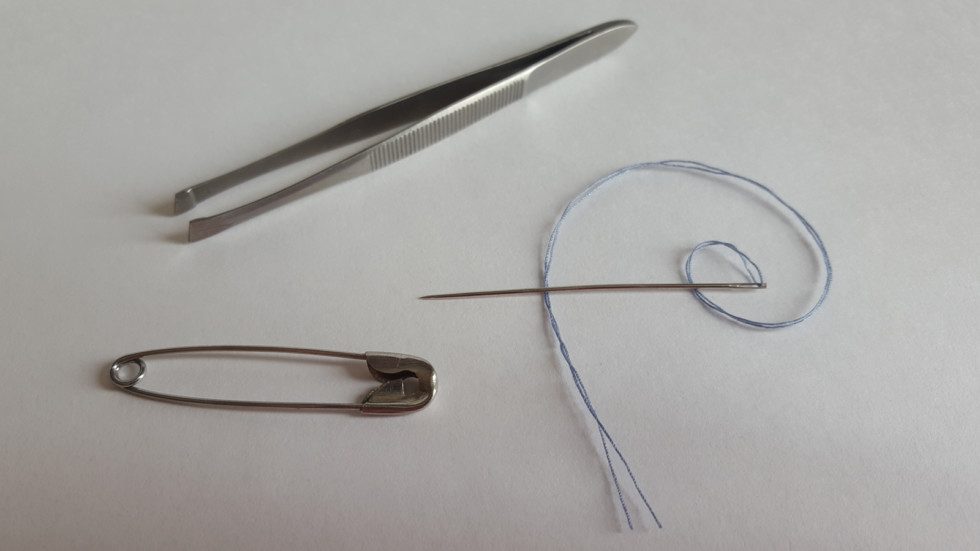
Another useful drug that you will not find in the store medicine cabinet is powdered streptocide. It is sold in small two-gram paper bags. They should be generously sprinkled on torn or cut wounds before bandaging - this will disinfect the wound and help it dry quickly.
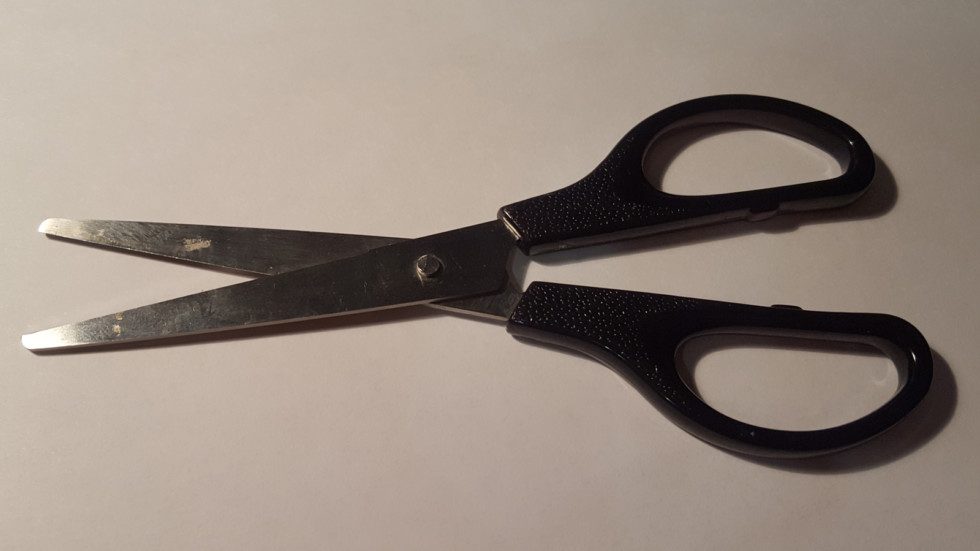 Oh yes – and don’t forget the scissors! Good, brand new office scissors that can not “chew” bandages and plasters, but cut them effectively. Well, the trash that is in most first aid kits and is mistakenly called scissors can be safely thrown away.
Oh yes – and don’t forget the scissors! Good, brand new office scissors that can not “chew” bandages and plasters, but cut them effectively. Well, the trash that is in most first aid kits and is mistakenly called scissors can be safely thrown away.
Well, the most important thing is to know what exactly you have available, to be confident in the safety of the contents of the first aid kit by checking it regularly, and, of course, to be able to use it! After all, without basic knowledge of first aid rules and the effects of common over-the-counter medications, you will find yourself at a dead end, even if you have everything you need in your hands.
According to the laws Russian Federation Every car that drives on the country's roads must have a first aid kit. At the same time, despite the fact that many drivers perceive this as a formality, its necessity is not questioned by any sane person. Traffic accidents happen so often on the roads that a normal and stocked first aid kit can save more than one life.
Naturally, the composition of a car first aid kit in 2017 is also strictly regulated. That is, the rules say detailed list, which indicates what should be in the car, in what quantity and of what quality.
The composition of what must be in the first aid kit of a vehicle is approved by the Russian Ministry of Health. This is their competence and prerogative.
At the same time, in recent years, the equipment for the car has been repeatedly revised and has become more consistent with the standards accepted in Europe. If we talk about changes, the general concept has changed.
Previously, a first aid kit in a car served to assist the driver and passengers in a variety of situations, which included various attacks and even poisoning. Now the emphasis is on providing first aid in case of an accident. That is, according to modern requirements, a medical suitcase is needed to stop bleeding, bandage wounds, and provide the most necessary assistance.
A complete list of what a driver must carry with him in a vehicle is given below.
Car first aid kit 2017 GOST composition
- hemostatic tourniquet (1 pc.);
- non-sterile gauze bandages (2 pieces each - 5cmx5m, 10cmx5m, 14cmx7m);
- sterile gauze bandages (2 pieces each - 7cmx5m, 10cmx5m, 14cmx7m);
- dressing bag (1 pc.);
- sterile medical wipes (1 pack);
- bactericidal adhesive plaster (10 pcs. - 1.9x7.2cm, 2 pcs. - 4x10cm);
- adhesive plaster roll 250 meters long;
- means for pulmonary resuscitation "mouth - device - mouth";
- medical gloves (1 pc.);
- scissors (1 piece);
- case (1 pc.);
- instructions for use.
As can be seen from the list above, in 2016 the composition of the first aid kit in a car does not include any medicines. Accordingly, traffic police officers cannot demand them.
However, this does not mean that the car owner cannot carry medications with him. If he thinks that some drugs will be useful to him on the road, then he can and should take them. Of course, from among those permitted for free circulation and use in Russia.
Where can I buy it?
It is worth noting that specialized stores have been offering ready-made first aid kits for a long time. They are produced by various companies in the form of ready-to-use suitcases. You just need to buy it and put it in your car.
However, you need to be careful. Despite the fact that organizations issuing finished products know the composition of the items in the first aid kit in 2016, they may make a mistake, for which they will have to pay out of their own pocket.
Therefore, when buying a ready-made first aid kit in a store, it is advisable to spend 5 minutes and check its composition with the list, which is reflected in the corresponding GOST. The car first aid kit becomes the property of the driver and he will be asked for it.
Price new first aid kit for a car may vary depending on the manufacturer and configuration (often additional items are added there that are not always necessary).
Statistics last year shows that it is quite possible to purchase a ready-made medical kit for no more than 500 rubles.
By the way, according to the new rules, the fine for the absence of a first aid kit or its understaffing is also 500 rubles. Accordingly, once you buy a suitcase with first aid supplies, it will pay for itself every time it is checked by the traffic police.
Do not forget that medical first aid products have a certain expiration date. According to the new rules, it is 4.5 years. After this, the first aid kit will become unusable and a fine may be imposed upon inspection.
What should you add yourself?
As already written above, the driver himself has the right to decide what he needs on the road in excess of the norm established by law. There are many recommendations that advise slightly expanding the composition of a first aid kit for a car. In 2017, these recommendations have not lost their relevance and may well come in handy.
Additional items and medicines:
- Clean napkins, iodine solution, brilliant green.
- Special packages for rapid cooling.
- Anti-burn drugs and dressings.
- Antiseptics.
- Disposable syringe and ampoule of baralgin (for local anesthesia).
- Remedies for high fever and allergies.
- Anti-poisoning agents (for example, Smecta).
Naturally, in case of any health problems, when there are medications prescribed by a doctor and indicated for periodic use, you need to take them with you. If these are some unusual and specific medications, then they should be kept in a visible place, accompanied by detailed description when, how and how much the patient takes them.
Driving your own car is always risky - in news and reports emergencies They constantly show reports from accident scenes. The driver must not only understand the Rules of the Road, he must also be able to provide first aid to victims. A certain number of hours during training in a driving school are devoted to providing first emergency aid.
Stopping the bleeding, bandaging a wound, fixing a broken bone and applying a splint is possible only if you have everything you need at hand - bandages, plaster, tourniquet, napkins, scissors, and so on. All these products are included in a car first aid kit.
In this article we will consider the following questions:
- car first aid kit and approved composition;
- what can you add to your first aid kit?
- contents for route vehicles;
- Is there a penalty for not having one?
Which first aid kit is approved in 2017?
To pass a technical inspection, a first aid kit, as well as a fire extinguisher and a warning triangle, must be in the car. It is a plastic container or fabric bag with a red cross on it. Any auto parts store can offer you a first aid kit; its price ranges from 300-500 rubles.
It must be said that the composition is approved by the relevant decree, so no matter how much you pay for it, there must be:
- non-sterile bandages, two packages measuring 5 by 5, 5 by 10, plus one package 7 by 14;
- the same number of sterile bandages;
- tourniquet to stop bleeding;
- one sterile dressing bag;
- medical sterile wipes - one set;
- adhesive plaster measuring 4 by 10 (2 pieces), 1.9 by 7.2 (10 pieces);
- adhesive plaster in a roll - one roll.
In addition, you should also have: scissors for cutting bandages, disposable medical gloves, a tube for mouth-to-mouth artificial respiration.
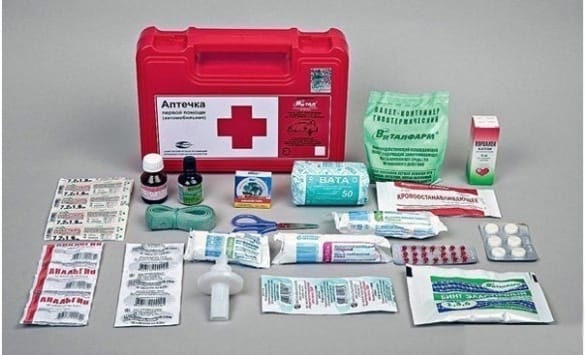
This composition was approved by order of the Ministry of Health and Social Development in 2009, and began to operate in 2010. As you can see, the first aid kit includes only products that can only be used to stop the bleeding. There are no medications of any kind. This is because most people in emergency situations can only worsen the condition of the victims by giving them the wrong medicine. In addition, if a person is injured and cannot utter a word, he is unlikely to say whether a particular drug is allowed for him.
Thus, the average driver is required to:
- call an ambulance immediately;
- provide all possible assistance to stop the bleeding using a tourniquet, bandage and plaster
In the same cases, if the condition of the victims is too serious, it is necessary to use the knowledge acquired in a driving school without changing the position of the bodies, since this can lead to even more fatal consequences.
When purchasing a first aid kit, you need to pay primary attention to the expiration date of the materials - if they are expired, you will not be able to pass the inspection. The composition must be replenished if anything has been used to provide assistance, or its expiration date has expired. In short, check the production date of each set.
If you buy a fully stocked first aid kit, it usually has a shelf life of 4 and a half years.
Well, the last point - there must be clear instructions for use. The case itself must be in good working order - close firmly, open easily, so that bandages and adhesive plasters do not lie around the car or in the trunk.
What to add to your first aid kit?
It is worth saying that before the order of the Ministry of Health and Social Development came into force, the composition was slightly different.

In addition to dressings, the first aid kit included:
- analgin and aspirin;
- sodium sulfacyl - used for instillation into the eyes in case of foreign bodies or conjunctivitis;
- cooling package container;
- nitroglycerin - helps with heart pain;
- Corvalol;
- activated carbon;
- stanine - hemostatic powder to stop minor capillary bleeding;
- cotton wool;
- ammonia.
In principle, no one now prohibits buying and supplementing a first aid kit with these items, but the dressing materials listed above must be included.
In the West, for example, there must be cold packs for applying to damaged parts of the body. Heat-resistant blankets are also used, thanks to which you can avoid hypothermia if a person is lying on the snow or ground, and you cannot move him until doctors arrive, as this can cause even more harm to the body.
In addition, people suffering from certain chronic diseases must carry with them all the required medications that are prescribed by their attending physicians. Very often, accidents also happen because a person became ill while driving, and the medicine that would help him was not in the medicine cabinet.
First aid kit for route vehicles
More stringent requirements are put forward for the equipment of buses, especially those that. According to regulations, a school bus must have 2 first aid kits, which include:
- two tourniquets to stop bleeding;
- packaging of absorbent cotton wool;
- 5 dressing bags;
- tweezers, scissors, pins;
- tire, tire-collar;
- scarves;
- 2 rescue blankets, 2 sterile sheets.
There should also be bandages, bactericidal patch, nitroglycerin, eye drops albucid, iodine, butorphanol tartrate - a strong pain reliever.
The content can be supplemented in cases where, for example, a group of disabled children, pensioners, or Chernobyl survivors are transported for treatment. Bus drivers undergo more extensive training to obtain a category D license, and therefore have a good understanding of when to use a particular drug and how to provide first aid.
What is the penalty for not having a first aid kit?
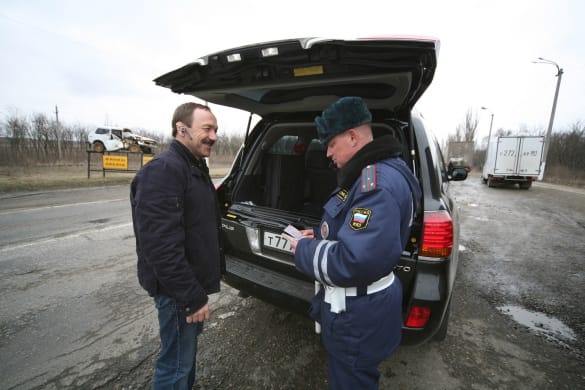
This question is quite relevant, since often inspectors stop cars with one sole purpose- find a reason to force the driver to pay outright or issue a fine. Do they have the right to do this?
According to the provisions for the approval of a vehicle for operation (clause 7.7), as well as traffic regulations (2.3), a first aid kit, a fire extinguisher and a stop sign are mandatory. If they are not there, then a fine will be issued under Article 12.5 Part 1 of the Administrative Code - 500 rubles.
It is worth noting that any driver knows how to get out of this situation - you can easily say that he was driving along the road and gave a first aid kit or individual items to help the victims, and now he is going to the nearest pharmacy to replenish the contents.
In addition, the presence of a passed MOT indicates that you had a first aid kit during the inspection. Accordingly, you are not required to show it to the inspector.
Also, according to the Ministry of Internal Affairs, there must be an appropriate reason for stopping:
- violation of rules;
- inconsistency in technical condition (visually noticeable, for example, black smoke from the muffler or obvious overload);
- non-working lights, missing or dirty license plate;
- carrying out special operations.
If they stop you and say: “Show me your first aid kit,” you can safely say that this is not a valid reason for stopping. Thus, you can always avoid a fine for not having a first aid kit. However, do not forget that anything can happen on the road.
For many drivers, having a first aid kit in a car is a purely formal thing... Most of Car enthusiasts purchase this “object” for only one purpose - to undergo the next technical inspection of the vehicle. And it is not surprising that the contents of a car first aid kit are often a set of useless medications that, in an emergency, cannot help the victim in any way.
First aid kit from the store - what's in it?
The current requirements for car first-aid kits, which exclude medications from them and leave only dressings, have been in effect since July 1, 2010. After their introduction, there was a lot of noise about how the previously useless first aid kit had become even more useless, but, unfortunately, these conversations have long died down. And many of the neophyte drivers who increase the number of drivers every year simply do not think about the fact that a ready-made first aid kit bought automatically on the principle of “you have to, then you have to...” is only a “disclaimer” for a technical inspection. An excuse, that is. There is a first aid kit, there is a certificate - that means order. However, the actual contents of the medical boxes can only cause nervous laughter among those who understand... Let's see what the contents of three different first aid kits look like, which we bought for 100, 200 and 250 rubles.
2016-2017
The hundred-ruble first aid kit, the size of one and a half fists, is attractive due to its compactness - it can be conveniently placed in the glove compartment or door pocket. But filling it is a complete failure... Obviously, the main element of the content is a certificate of conformity valid until November 2017. It is, of course, necessary during a technical inspection - but it will only help with it: in case of real injuries, the first aid kit does not even need to be opened...
Compound:
- Non-sterile gauze bandage 5 m x 7 cm – 2 pcs.
- Adhesive plaster sticker – 1 pc.
The “hemostatic tourniquet” is a natural piece of elastic from panties, there are simply no sterile bandages, and the adhesive plaster is represented by one measly piece of paper!
Such a set should be given to a child immediately after the technical inspection to play doctor - it is good for nothing else.
We take on a set that is twice as expensive – for 200 rubles. But is it twice as good?
Compound:
- Hemostatic tourniquet – 1 pc.
- Adhesive plaster sticker – 2 pcs.
- Mouth-to-mouth artificial respiration device – 1 pc.

This set-up at least already has a sterile bandage, not one, but two “slap” patches, and a thin roll of tape has also been added. But, to be honest, it’s practically the same thing... And the verdict is the same - a child’s toys!
And the last set - for 250 rubles. A large suitcase with a handle, giving hope for more or less decent contents. What's in it?
Compound:
- Hemostatic tourniquet – 1 pc.
- Non-sterile gauze bandage 5 m x 7 cm – 1 pc.
- Non-sterile gauze bandage 5 m x 5 cm – 1 pc.
- Sterile gauze bandage 5 m x 7 cm – 1 pc.
- Sterile gauze bandage 5 m x 5 cm – 1 pc.
- Adhesive plaster sticker – 2 pcs.
- Rolled adhesive plaster – 1 pc.
- Mouth-to-mouth artificial respiration device – 1 pc.
- Scissors – 1 pc.
- Non-sterile gloves – 1 pc.
But even here, in reality, the set shows its complete inconsistency: there are still two patches, there are a little more bandages, and the hemostatic tourniquet is a little more serious - nylon tape with Velcro in a vacuum bag. It would be hard to call this set essential. And after you pick up the scissors and gloves, you realize that a first aid kit for 200 rubles is even more honest than the one that costs 250! Scissors are a kind of mockery: crooked and skewed, it is impossible to cut even a slice of cheese with them. The gloves are made of the thinnest polyethylene bags - these are the kind that are available for free at some glamorous gas stations, so as not to get your hands dirty from the gun...
 In a word, to pass a technical inspection, a first aid kit for 100 rubles is enough - those that are two to three times more expensive have similar certificates of conformity and are just as useless for their intended use as a hundred-ruble box, so there is not the slightest sense in paying more than a hundred . This means that we will independently assemble a normal first aid kit, which can really help out in case of medical problems along the way.
In a word, to pass a technical inspection, a first aid kit for 100 rubles is enough - those that are two to three times more expensive have similar certificates of conformity and are just as useless for their intended use as a hundred-ruble box, so there is not the slightest sense in paying more than a hundred . This means that we will independently assemble a normal first aid kit, which can really help out in case of medical problems along the way.
2017

We are collecting a car first aid kit!
When collecting the components of the first aid kit, we divide its contents into three groups:
- Dressings
- Disinfectants
- Medications
“In a modern first aid kit, the contents are a very imperfect set of first aid for injuries and various bleeding,” says Nikolai Nikitenko, a rescuer with 20 years of experience, head of the software and information support service for the Tsentrospas detachment.
“The store first aid kit is absolutely missing the so-called individual dressing bags and cooling packs. It is extremely difficult to bandage a wound more serious than a cut with thin gauze strips of bandages - this is what the individual dressing package is designed for. And cold for bruises will be provided by hypothermic bags, the chemical composition of which, when mixed by crushing, produces an ice compress.”
Following the advice of an experienced rescuer, we will add to the symbolic bandages of a first-aid kit several rolls of sterile and non-sterile bandages, a roll of cotton wool, as well as a plate with a dozen sticker patches and a roll of plaster. By the way, if we take all the dressing materials from all three first aid kits that we gutted for research purposes, then at the very least there will be enough bandages for one more or less normal set! Bandages last a long time, so they only need to be renewed as they are used. 
Not in every modern pharmacy you can buy an individual dressing package - the same army one, in a sealed package made of rubberized fabric. This is what car first aid kits used to be equipped with, and they were widely sold. Today, finding this package in a pharmacy is possible, but not easy. Its readily available analogue is bandage patches with dimensions of 15x9 centimeters and 8x6 centimeters. In principle, this is actually the same thing - a bandage is placed on the wound and, to be sure, it is bandaged on top with a non-sterile or sterile bandage. You should have several of these in your car first aid kit, especially since they are cheap and easily stored for several years. 
For bruises or fractures, apply cold to the injured area. Chemical cooling packs are used for this purpose. The general package contains banal ammonium nitrate powder and a separate bag of water. The container with water is destroyed by a blow of the palm, after which the water and saltpeter are mixed. During the dissolution reaction, active heat absorption occurs - the bag becomes very cold.
Hypothermic bags are cheap; it is advisable to have 3-4 of them in your first aid kit. They can be stored for a year or two, but are structurally weak: they require a first aid kit in the form of a hard suitcase to protect them from unfortunate proximity to the cargo in the trunk - so that they do not leak. 
Now about disinfectants. As the hero of “High Security Vacation” performed by Bezrukov said, “we choose the classics,” namely, iodine, hydrogen peroxide and alcohol. Oddly enough, the classic packaging in medical bottles with a volume of 40–50 milliliters is most convenient for a car first aid kit, in contrast to expensive “pencils” and the like. Good old bottles are the cheapest, their double stopper (plug + screw cap) is reliable, and the glass walls are thick - the risk of breaking in a car first aid kit is extremely low. Hydrogen peroxide costs less than 10 rubles - so it is advisable to use one bottle as a container for alcohol - just pour out the peroxide, fill the bottle with alcohol and stick on the appropriate label. 
“There is no need to keep heart medications, vascular medications, antiallergic medications and other specialized medications in the car first aid kit “just in case,” says emergency physician Anatoly Belov.
“A single driver who knows his diagnoses should have vital medications in a separate mini travel bag, stored not in the car, but in a purse with documents and keys. The passenger needs to act similarly if he is a stranger to the driver. If you are planning a family trip, then the medications needed for each need to be temporarily added to the first aid kit, and after returning, take away everything unused from there to avoid damage.”
It is worth keeping a minimum of medications in your car first aid kit at all times for sudden problems that are not related to chronic diseases, inexpensive and that can be replaced at least once a year without much damage due to difficult storage conditions. On a long road, in the outback, far from populated areas, pharmacies and hospitals, the following most often happens to a driver:
- Various types of pain - headaches, muscle pain, etc.
- Stomach problems, diarrhea, poisoning
- Colds, sore throat
For pain of a different nature, banal analgin, baralgin and No-Shpa are sufficient, which, even expired, will not turn into poison, although they will reduce effectiveness. Painkillers will allow you to get to your destination safely, thinking about the road, and not about the pain, and then see a doctor. The well-known Phthalazol, Smecta, Mezim, Imodium and the like will help with gastrointestinal problems. In case you get a sore throat, a runny nose, a cough, or even a rise in temperature along the way, again, there is no need to carry all imaginable medications with you. You need to get home without getting into an accident due to weakness and fever, and then begin full treatment there! Therefore, in your car first aid kit for such a case, you should only have a couple of sachets of soluble express powders like Teraflu or analogues. Impact doses of paracetamol and ascorbic acid will not cure, but will relieve symptoms and bring you to your senses. Well, put a blister of plain aspirin too. That, in general, is all you need to know about the basic medicinal part of a first aid kit! 
An “anti-splinter” kit in a separate bag is very necessary and useful in a car first aid kit. It should include a sewing needle or pin and nail tweezers. And to disinfect instruments and the “operation” site, that same small bottle of alcohol is used. 
Another useful drug that you will not find in the store medicine cabinet is powdered streptocide. It is sold in small two-gram paper bags. They should be generously sprinkled on torn or cut wounds before bandaging - this will disinfect the wound and help it dry quickly. 
Oh yes – and don’t forget the scissors! Good, brand new office scissors that can not “chew” bandages and plasters, but cut them effectively. Well, the trash that is in most first aid kits and is mistakenly called scissors can be safely thrown away. 
Well, the most important thing is to know what exactly you have available, to be confident in the safety of the contents of the first aid kit by checking it regularly, and, of course, to be able to use it! After all, without basic knowledge of first aid rules and the effects of common over-the-counter medications, you will find yourself at a dead end, even if you have everything you need in your hands.
From January 1, 2017, the composition of first aid kits for cars will be changed in Belarus. Thus, the amount of medicines has been reduced, the amount of dressings has been increased.
Usually, most car owners remember to carry a car first aid kit before a technical inspection. To receive a sticker, the first aid kit, the condition of which is checked by maintenance staff, must contain everything necessary.
The Ministry of Health of Belarus optimized investments in car first aid kits back in December 2014 with Decree No. 80 “On establishing lists of first aid kits, emergency kits medical care, the investments included in these first aid kits and determining the order in which they are completed.”
By that decree, tablets were removed from the list of necessary items - including validol and nitroglycerin. At the same time, the requirement for the amount of dressing material was increased.
New requirements were not immediately introduced and travel was allowed from old configuration first aid kits until the end of this year. But from January 1, 2017, a car first aid kit must comply with the regulation. Thus, the composition of a car first aid kit for 2017 should be as follows:
Ammonium solution 10% - 1 ml No. 10 (vial 10 ml, 40 ml);
Iodine alcohol solution 5% – 10 ml (40 ml) or 1 ml No. 10, one package;
Sterile medical bandage 5 m x 10 cm, one package;
Non-sterile medical bandage 5 m x 10 cm;
Non-sterile medical bandage 5 m x 5 cm, two packs;
Medical elastic tubular non-sterile bandage No. 1, 3, 6;
Absorbent cotton wool sterile 50 g;
Esmarch's hemostatic tourniquet;
Bactericidal adhesive plaster: 2.5 x 7.2 cm - 3 packs and 4 x 10 cm or 6 x 10 cm - 1 pack;
Roll adhesive plaster 1×500 cm or 2×500 cm, one package;
Blunt scissors 14 cm (1 pack);
Non-sterile latex examination gloves (sterile) No. 8 (L), one pair;
Portable hypothermic (cooling) pack, one package;
Sterile wipes 16*14 (45*29) cm, 4 packs;
Instructions for using attachments (can be purchased at any pharmacy or downloaded and printed from the link below).
The Ministry of Health reported the following: “As practical experience shows, a hemostatic tourniquet of the Esmarch type is one of the most reliable and simple devices for compressing the soft tissues of the limb in order to temporarily stop bleeding and, therefore, is preferred for use in first aid provided by any persons within the framework of self- and mutual assistance. With regard to scissors, the main requirements for them are ease of use and safety. Convenience is achieved due to the optimal overall length of the scissors, and safety is achieved due to the blunt shape of the scissors.”
You can assemble a first aid kit yourself, or you can purchase a ready-made and complete one.
It should be noted that in addition to the mandatory composition, everyone has the right to add to the first aid kit those drugs and components that they consider necessary. However, if you have “additional” drugs in your medicine cabinet, it is worth considering that in some countries, medications approved for use in Belarus may be considered narcotic or prohibited, and their possession is subject to criminal liability.
For example, in Ukraine, back in 2013, potassium permanganate, known as potassium permanganate, was included in the list of substances used for the manufacture of drugs, and therefore is prohibited for import into the country.
Download instructions for using car first aid kit attachments
Instructions for the use of medicines included in the first aid kit for equipping vehicles.- New
- Features of the speech of a child entering first grade
- Communication as a way of psychological influence
- Strength, endurance, mobility, lability and balance of nervous processes
- Luzhkov is an honored brewer, and Chubais is an honorary Chechen
- Absolute measurement error
- "Distributed brain" of an ant family
- See what “human chromosome 15” is in other dictionaries Quantitative chromosomal abnormalities
- The “distributed brain” of an ant family Why do ants walk on water?
- Tatar legends about zul-qarnain Tatar legends and traditions
- Popular
- Pancakes from children's instant porridge
- An easy way to surprise your guests
- Chicken pancakes with photos for children
- Curd desserts for children Curd sour cream recipe
- What to cook with apples
- Dried fruit compote: how is it useful and are there any contraindications?
- Search results for \
- Parent meeting in the preparatory group: “Farewell, kindergarten!
- Speech therapy session









